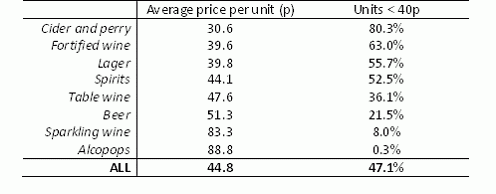The Home Office has today published its alcohol strategy which contains a number of measures designed to curb excess alcohol consumption and the associated social harms. The most high-profile is the plan to introduce a minimum price per unit of alcohol in England and Wales (a similar policy is currently before the Scottish Parliament), with 40p per unit set as an illustrative rate.
As in our previous analyses of minimum pricing, we continue to argue that a preferable approach would be to introduce a floor price for alcohol through the duty system, moving towards a more equal tax treatment of alcohol by type and strength combined with a restriction on selling alcohol below the total tax levied on it. Such a system could be designed to achieve an increase in the price of low cost alcohol similar to that that from a minimum price. But it would have the advantage of raising money for the Exchequer, whereas a minimum price would transfer revenues to the alcohol industry instead. If set at 40p, we estimate that these transfers could be as much as £850 million per year. The alcohol strategy document suggests that the government will "... work with industry to use any additional revenue to provide better value to customers in other areas ..." though quite how this could be enforced or monitored is hard to see.
How significant would a 40p minimum price be? We examine the policy using detailed data recording the off-licence alcohol purchased by more than 19,000 households in 2010. The data do not include alcohol bought in pubs and restaurants. However, it is unlikely that a minimum price would have much direct impact for on-licence prices.
Table 1 shows that the average off-licence alcohol unit sells for around 44.8p. Overall, 47% of units would be directly affected by the proposed minimum price. The policy would therefore have a significant impact for off-licence alcohol retailing, and would not simply affect the very bottom of the price distribution. There are also substantial differences across alcohol types. Over 80% of cider units are directly affected. By contrast, alcopops and sparkling wine would be relatively unaffected.
Table 1: Average retail price per unit and proportion cheaper than 40p, by alcohol type

Source: calculated using data from Kantar Worldpanel, 2010. Note: prices uprated to February 2012 values using the all-items Retail Prices Index from the Office for National Statistics.
Off-licence purchase prices vary by household income and by overall alcohol consumption level. The average price for those with incomes below £10,000 per year is around 42p per unit, compared to 51p for those above £60,000. Households consuming fewer than 7 units of alcohol per adult per week pay almost 49p per unit, compared to 41p for those consuming more than 35 units. The policy would therefore affect low income and heavy drinkers more directly. Moderate consumers, though, are quite substantially affected as well: 37% of units purchased by those drinking fewer than 7 units per week cost less than 40p, compared to 59% for those drinking more than 35 units.
Table 2 estimates the average increase in total food and drink expenditure by income and consumption group following a 40p minimum price. It assumes that there is no change in consumer or retailer behaviour other than an increase in the price of alcohol below the threshold. The average cost is about 0.6% of grocery budgets, or £21 per year in cash terms. The largest impact is felt by low income, heavy drinkers who lose 5.9% of their grocery budget on average. The measure is slightly regressive overall, though the differences across income groups are not particularly large and it would not seem sensible to judge the policy simply on its distributional effect.
Table 2: Increase in food and drink grocery budget following 40p minimum price, by income group and average weekly off-licence consumption level

Source: calculated using data from Kantar Worldpanel, 2010. Note:
This analysis does not attempt to model the behavioural response to minimum pricing. However, many of the potential effects are hard to predict. In particular, how would retailers and manufacturers change the price of more expensive alcohol? What would happen to the range of products on the market? What would happen to non-alcohol prices? These indirect effects could be very significant. The coalition may benefit from a Scottish laboratory if the policy is implemented by Holyrood first. The impact of minimum pricing in Scotland should therefore be robustly evaluated with the policy in England and Wales being responsive to any lessons learned.









